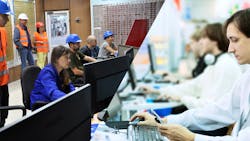In this wonderful and interconnected age of information, perhaps the best thing to come from all of it is the ability to deliver information to the right person at the right time in the right context. We can target our message and deliver our information to just the right person. That makes information more useful.
Sometimes we’ve depended too much within our organizations on these tools. The information can lack context, or what we used to call “the human touch.” And with the events of the last couple of years, the human element has had to take a back seat to our need for safer conversations.
But that still shouldn’t get in the way of making sure we continue to make valuable connections with other parts of our organization. One area we’ve focused on in our Feb/March issue's cover story—and one that will be the focus of a great deal of coverage throughout this year and beyond—is the relationship between the design and operations teams. The traditional silos that have existing in several parts of an organization are being demolished not just with better communication tools, but also with a better understanding of how connected enterprises can be more efficient and effective.
This is especially true for the design and operations teams. System design is only effective when it produces products that meet all the expected quality, safety and productivity standards. Yet that is not a fixed standard; there’s always room for process improvement, both at the initial design stage as well as at regular review intervals. The operations team can influence effective design from conception, but it also can provide real-world feedback on how that design has performed.
The design team also can better create and optimize process design with a fuller understanding of the capabilities and limitations in operations. They can design a system that takes full advantage of those skills and delivers the best version of efficiency on Day 1.
Such an outcome isn’t accomplished simply with communications, however. It’s achieved through understanding the message being communicated. Whether through the use of our modern tools or across a table, gaining a deeper insight into the challenges and opportunities within the entire design-to-operate process is a worthy aspiration.
And as we seek to communicate this month, it’s also a competitive advantage.
About the Author

Bob Vavra
Editor Emeritus, Machine Design and Power & Motion
Bob Vavra is the former senior content director of Machine Design and Power & Motion.
